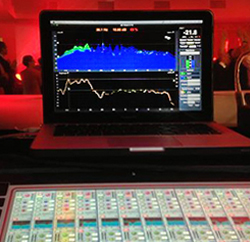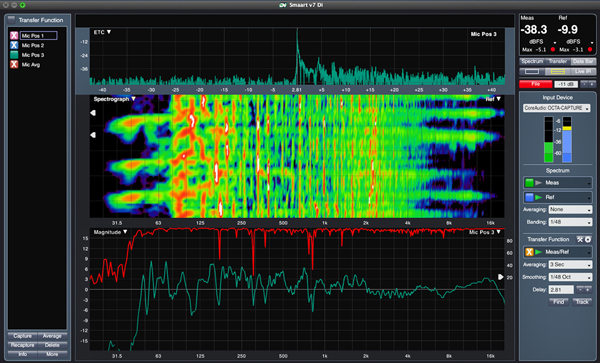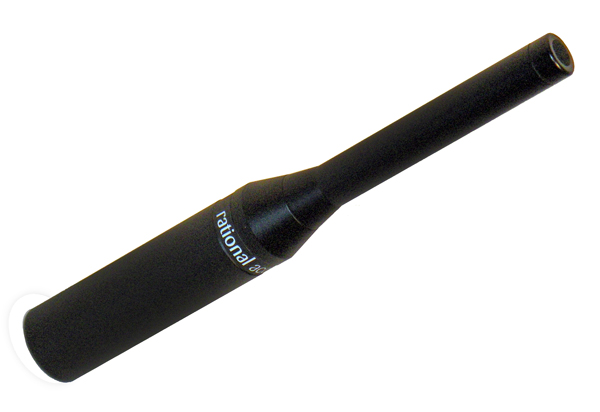Released last year, Rational Acoustics Smaart v.7 Di (dual-channel interface) is a streamlined (and less expensive) 2-channel version of industry-standard Smaart v.7 multichannel analysis software.
Yet while v.7 Di is a simplified version, it still uses the same powerful and efficient Spectrum and Transfer Function measurement engines as v.7.
Smaart is a Fast Fourier transform (FFT) measurement system that transforms “Time Domain” audio signals into frequency domain “Spectrograph” response displays when making single-channel measurements – great as a visual reference of a measurement microphone or the output of a cue bus being monitored.
The power of FFT is in its 2-channel measurements, typically comparing a signal sent to a loudspeaker with the sound coming out of it, in order to show its frequency response. Further, you can make these measurements using almost any source material that is “dense” enough for the signal, not just pink noise.
Seeing It
My “light bulb moment” with Smaart came in 1996 at a multi-band festival. Placing my Pentium PC laptop on the drive rack and simply taking a board feed and putting up a measurement mic, I could quickly and easily identify and tame a few rough spots by tweaking the main graphic EQ while the band before mine was playing on stage. No “hoo-hoo, ha-ha, test one-two” into an SM58 board mic needed.
As a monitor engineer, I could line up all of the wedges-du-jour and quickly take a picture (capture a trace) of each one’s frequency and phase response to find the problem child in the bunch. There’s almost always one bad apple: someone replaced a driver and either used a substitute model or got red and black confused.
At front of house, essential daily 2-channel measurements include timing the front fills and delays with the main loudspeakers by subtracting their arrival times, as well as aligning subwoofers to the mains.
Removing Complexity
The Smaart v.7 Di user interface (UI) is functionally similar to SmaartLive, a previous version on which many of today’s power users first learned over a decade ago. For sound techs embarking down the path of FFT measurement, v.7 Di’s simpler user experience can flatten the learning curve and save money – and can later be upgraded to a full v.7 license.
New users get to learn the same controls and commands without the added complexity of the multichannel interface. Both v.7 versions use the same Spectrum and Transfer Function data formats, and both share the same on-screen controls and short-cut keystrokes, so moving back and forth between versions is easy.
All critical Spectrum and Transfer Function controls are visible simultaneously on the v.7 Di UI. Data is presented in what Rational Acoustics calls a “concise, single measurement pair” configuration that’s accessible from top level of the UI. This includes two Live Spectrum engines (one for each input channel), two channels of broad-band metering (one for each input channel), and one Live Transfer Function engine.
v.7 Di doesn’t include the full version’s Acoustic Tools or a separate impulse response (IR) mode. Time domain measurement capabilities simply reside in the transfer function’s Live IR display. And since it’s streamlined, v.7 Di has the ability to only measure one transfer function at a time.
Capture Point
Besides the software, the minimum needed for making 2-channel acoustical measurements with Smaart is a computer interface and a measurement mic, plus cables to connect computer, mic and interface to each other and a console.
Most professional audio systems employ balanced XLR connections, though a TRS adaptor can help occasionally. FireWire has faded and today most interfaces use USB, so a USB cable and a couple of XLRs is all that’s usually needed, cable-wise. Most USB interfaces get power from the computer, so you won’t even need the wall-wart.
The Rational Acoustics RTA-420 is an effective yet inexpensive measurement mic, similar to the RTA-M sold by dbx as an accessory for the DriveRack PA and 260 processors. You might not use it in a laboratory or a studio, but it’s a quality unit that’s “plenty good enough for rock ‘n’ roll.”
As you advance in your study and practice of measurement, there might be a desire to upgrade, with plenty of measurement mics available that range from a few hundred to a couple thousand dollars. I own an Audix TM1 and an ISEMcon EMX-7150, which are both rugged workhorse tour standards and cost about $300.






















